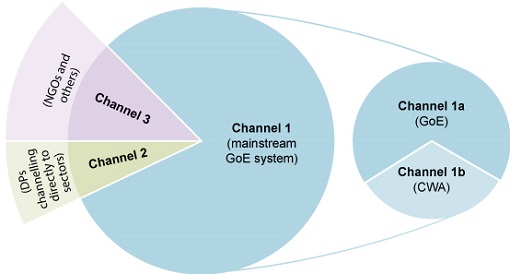12.3 Fund flow and channelling funds
The financial systems of Ethiopia are generally categorised into three ‘channels’, described in Box 12.1.
Box 12.1 Donor funding channels
Channel 1 is ‘on-budget’ and is managed by MoFED, regional Bureaus of Finance and Economic Development (BoFEDs) and woreda Finance Offices. ‘On-budget’ means included in the national annual budget description. Channel 1 is further divided into:
- Channel 1a: funds are transferred through MoFED to regional BoFEDs, and then to WASH sector bureaus and offices
- Channel 1b: also through MoFED but funds go directly to WASH sector bureaus and offices.
Channel 2 funds are made available directly to the WASH sector ministries (MoWIE, MoH, MoE) and then to their respective bureaus and offices at lower levels. Channel 2 is also ‘on-budget’.
Channel 3 funds are directly transferred by donors and aid agencies to service providers and the donor retains financial control. Channel 3 funds are ‘off-budget’, meaning they are outside the control of government and are not included in the national annual budget.
The preferred fund flow for the OWNP uses Channel 1b through the Consolidated WASH Account (CWA). The creation of the CWA marked a major change in fund flow for WASH activity that came about as part of the OWNP. The CWA, as you first read in Study Session 1, is a unified funding channel which allows all funds from major donors to be deposited in one bank account. The CWA provides a mechanism for all the major donors (fund contributors) to pool their resources. This simplifies the fund allocation process and avoids the fragmentation between different donors and programmes, a significant problem in the past. The CWA is opened and controlled by MoFED. Any transfers from the fund are controlled by MoFED, based on the rules and regulations of the government.
The CWA is a very important aspect of the One WASH approach. In the past, overseas donors would each have separate accounts in their own currency. It is a significant change that the CWA is a birr account. This means all WASH funds in any foreign currency contributed from development partners are changed into Ethiopian currency (birr) before being disbursed and used by implementing organisations. CWA funds are therefore considered to be government funds and are not linked to the identity of the fund source.
The term ‘non-CWA’ is applied to all funds that are not pooled in the CWA. Non-CWA fund contributors give their commitments directly to the implementing organisations at federal, regional or woreda levels. In this situation, the government financial management system is not applied.
In Study Session 9 you learned about the different types of stakeholder in the OWNP. Based on the flow of funds, how would you categorise the stakeholders channelling funds through the CWA and those outside the CWA?
Major stakeholders channel funds through the CWA and associated stakeholders channel theirs outside the CWA.
The relationship between the funding channels described in Box 12.1 and the CWA, and how this fits into the overall picture of finance in the OWNP is shown in Figure 12.3. As you can see, the CWA is only a part of the overall funding system for the OWNP. Significant contributions to the OWNP budget also come through Channels 1a, 2 and 3.

12.2.5 Water utility earnings
